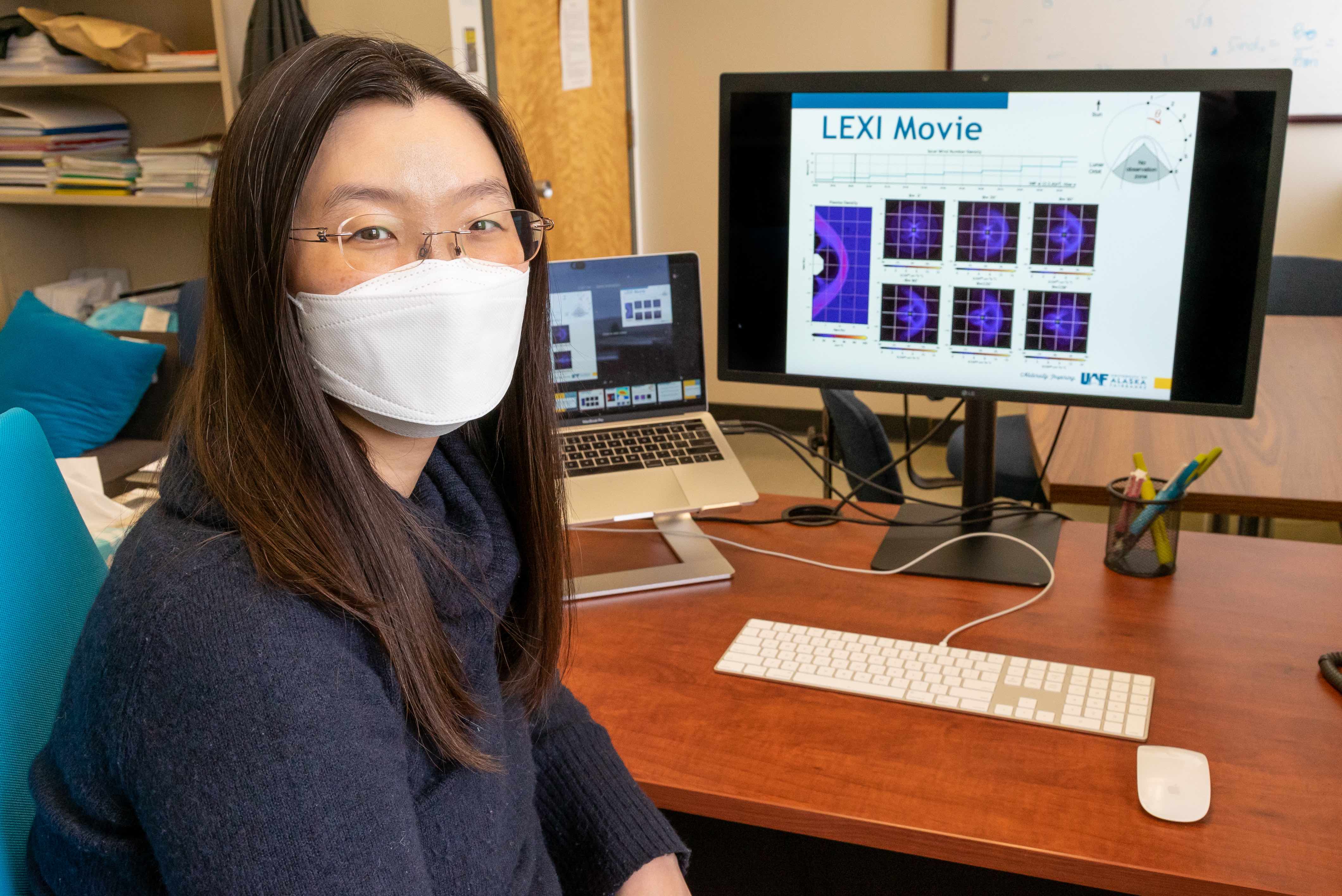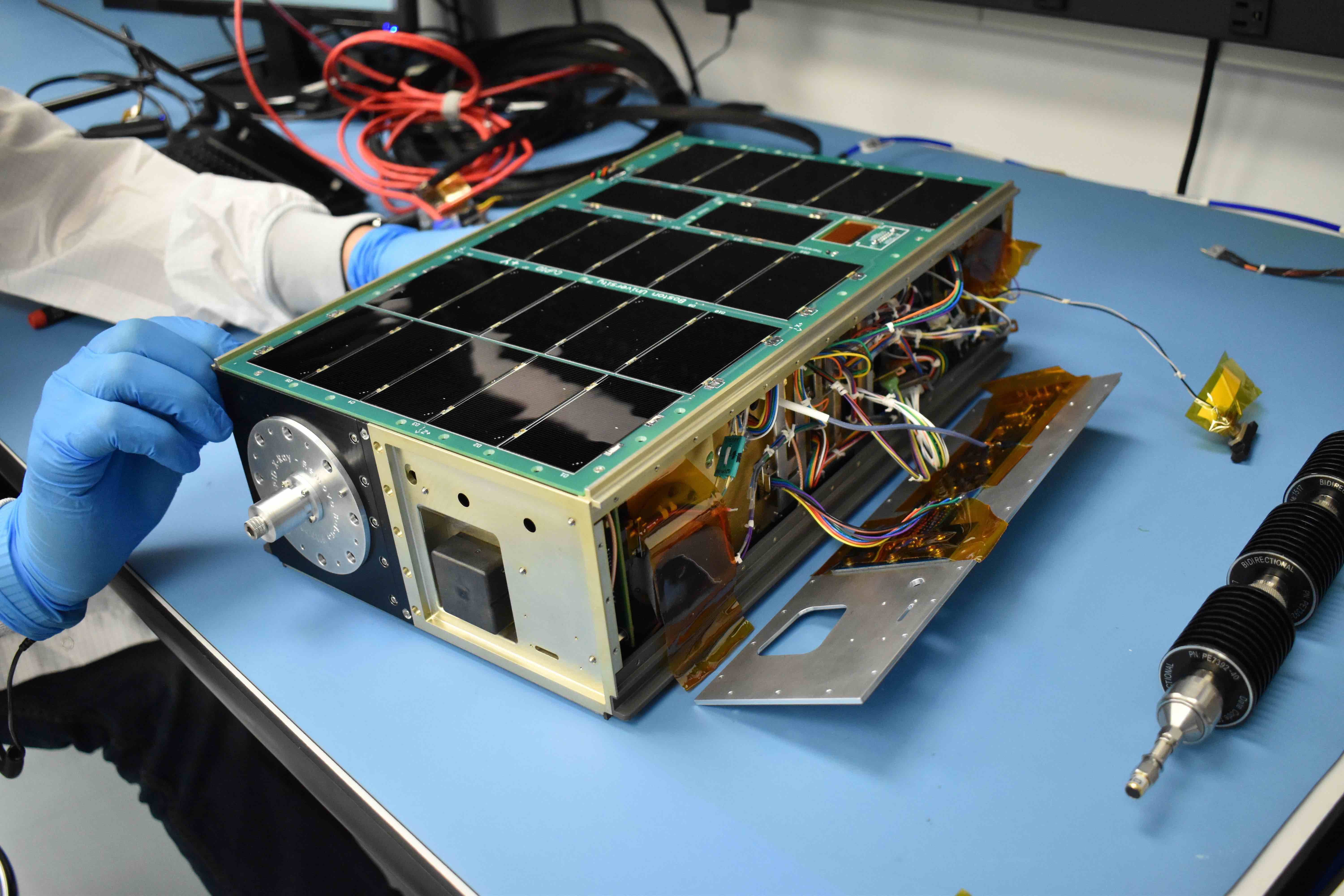Big space mystery gets big attention from UAF space physicist
Rod Boyce
907-474-7185
Sept. 14, 2021

UAF assistant professor Hyunju Connor works at her desk at the Geophysical Institute. Connor is a computer modeler for three missions researching the interaction of the solar wind with the Earth’s magnetosphere.
Associate professor Hyunju Connor is looking forward to the launch of an Alliance Atlas V 401 rocket from Vandenberg Air Force Base in California later this month.
She’s also looking forward to a rocket launch in 2023.
And another in 2024.
Connor is involved with a satellite component of each of the three launches in the quest to understand one of the big mysteries of space physics: the interaction of the solar wind with Earth’s magnetosphere through a process known as magnetic reconnection.
“Magnetic reconnection allows the solar wind particles to come into the Earth’s magnetosphere and create geomagnetic disturbances that could harm our infrastructure such as satellite systems or cellphone systems,” said Connor, a space physicist at the University of Alaska Fairbanks Geophysical Institute.
Knowing more about how magnetic reconnection works is important also for making accurate predictions about space weather so that humans can better prepare, whether here on Earth, orbiting in space or, eventually, living on Mars.
“There are big unanswered questions,” said Connor, who is also teaches in UAF's College of Natural Science and Mathematics.
Magnetic reconnection occurs throughout the universe, including on the sun’s surface, and drives space storms around the Earth. It occurs when two magnetic field lines interact, as when plasma-carrying magnetic field lines from the sun collide with the Earth’s magnetic field, which carries its own plasma, a gas in which atoms have been broken into free-floating electrons and ions.

In April 2021, Connor O'Brien and Emil Atz complete vibration testing of CuPID at the Goddard Space Flight Center in Maryland to ensure it can withstand the space environment.
When that happens, each magnetic field line breaks, causing the two parts of each to reconnect with the matching part of the other. And that causes an instantaneous release of energy as magnetic energy is converted to particle energy. Part of that energy discharges as visible light in the aurora.
Each of the three missions hopes to witness a reconnection, but the task is difficult because reconnection occurs on a small scale and the magnetosphere is so large.
“The reconnection happens in a very small area, approximately 10 to 100 kilometers in size,” Connor said. “But our magnetosphere is enormous, at 100 Earth radii (640,000 kilometers) from north to the south, and from the dayside to the night side it is several hundreds of Earth radii.
“That's why it hasn’t become clear where the reconnection happens and in what way it happens. Is it happening locally? Is it happening globally? Is it happening continuously? Or is it happening intermittently?” she said. “Those kinds of questions have not been answered because it's quite difficult to catch.”
Those answers could come from the three launches in which Connor is involved as a computer modeler, helping to project possible outcomes.
Each mission will carry a camera to look for low energy X-rays, which are emitted during the solar wind-terrestrial atmosphere interaction that occurs near the reconnection sites.

The CuPID satellite's chassis, or base frame, meets its avionics at the Goddard Space Flight Center in Maryland in December 2019.
The three missions are CuPID, LEXI and SMILE.
• CuPID
The Cusp Plasma Imaging Detector cubesat observatory will look for evidence of magnetic reconnection above the Earth’s poles using the first wide-view X-ray camera in orbit. It will launch at Vandenberg Air Force Base in California in late September.
CuPID, the size of a shoebox, is funded by NASA and led by Brian Walsh of Boston University, with involvement by Drexel University, NASA Goddard Space Flight Center, Johns Hopkins University, Merrimack College, Aerospace Corp., and the UAF Geophysical Institute.
• LEXI
The Lunar Environment heliospheric X-ray Imager will use an X-ray camera placed on the moon. Launch is scheduled for 2023. The research team is similar to that of CuPID, but with the absence of Drexel and the addition of scientists from the universities of Miami, Kansas and Leicester.
• SMILE
The Solar wind-Magnetosphere-Ionosphere Link Explorer, a mission of the Chinese Academy
of Science and the European Space Agency, aims to obtain the “first-ever observations
of the full chain of events that drive the Sun-Earth connection,” according to a project
report. Connor co-leads the modeling group for SMILE, scheduled to launch in 2024.
ADDITIONAL CONTACT: Hyunju Connor, 907-474-5421, hkconnor@alaska.edu
NOTE TO EDITORS: Photographs and a story-length version of this press release are available at gi.alaska.edu.


